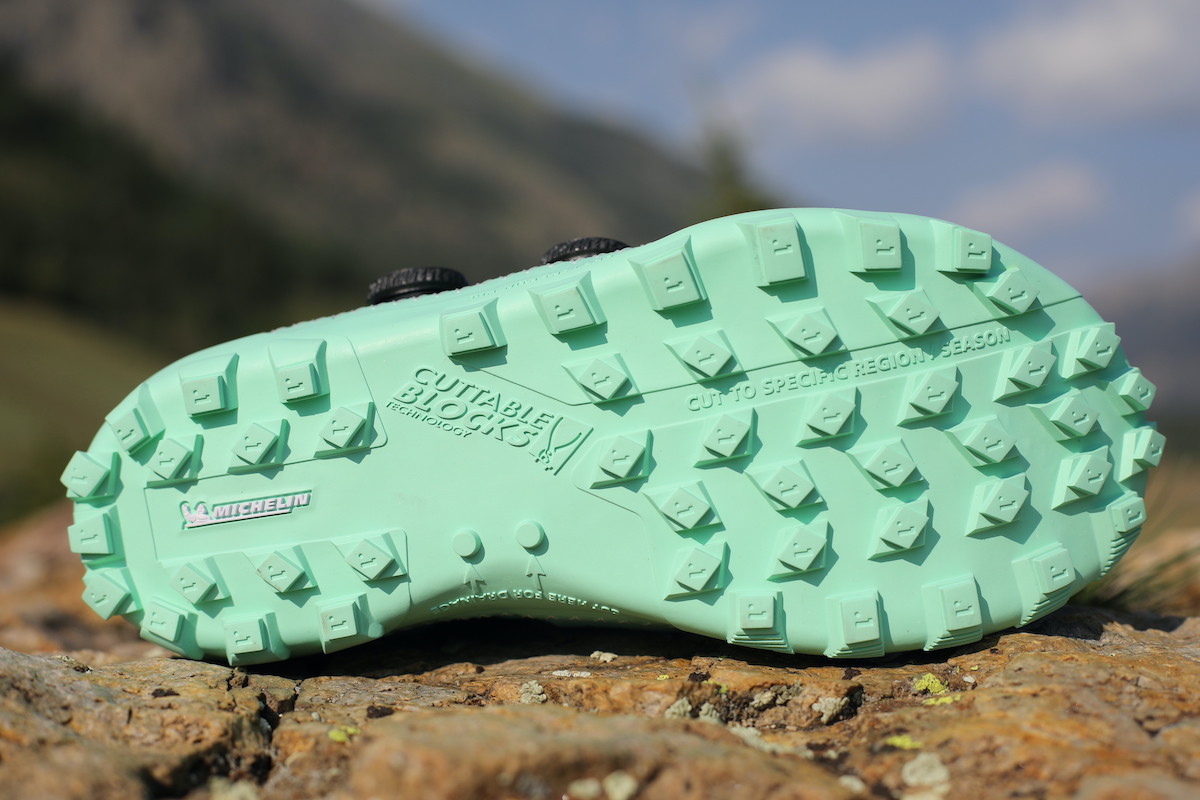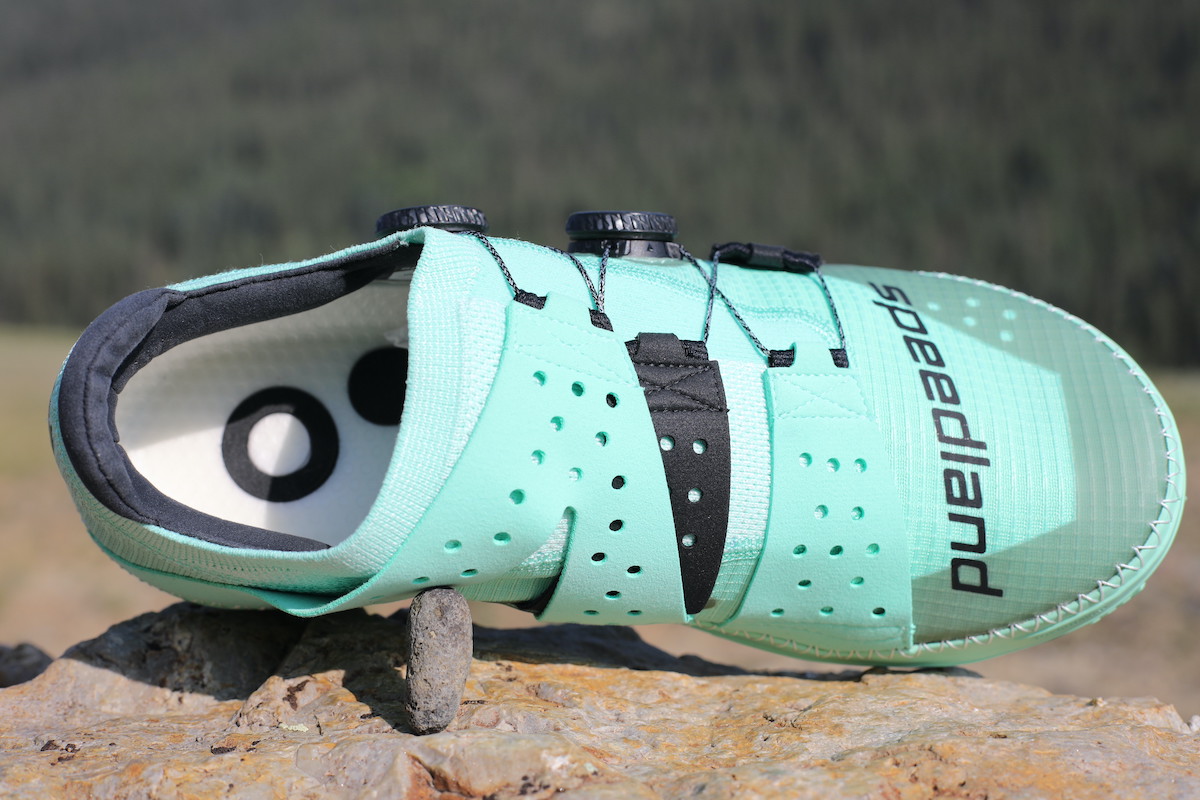The Speedland SL:PDX ($375) is an impressive shoe with some first-of-their-kind components.
When La Sportiva introduced the Cyklon in collaboration with BOA to try and create a “super shoe” for trail running, I admired the product and reviewed the La Sportiva Cyklon favorably. The SL:PDX took the Cyklon’s technology and elevated it to a much higher and more successful level. Why use a single dial when you could have two? The dual dials of the BOA Li2 Fit System make the SL:PDX’s upper one of the most remarkable I’ve ever used.
Similar to La Sportiva’s longtime small-factory, made-in-the-Italian-mountains ethic, Speedland’s debut shoe actually struck me as being hand-assembled and sewn with a collection of components by a human, instead of with only machinery or assembly lines. I imagined someone sitting in a comfortable chair, working the last by hand, moving to a high powered sewing machine to apply the Dyneema moccasin stitch to attach the upper to the outsole, going over to reams of fabric, selecting a large piece to cut out anatomically specific instep overlays, then threading the Dyneema TX4 textile lace, before finally gluing down the dials.
This fantasy may have been driven by the price tag. But in reality, the price perhaps reflects the lack of economy of scale — the company says only 1,200 pairs were made — and the use of some obscure components. If the price is double an average trail running shoe, it’s not a reflection of getting twice the miles out of the outsole. The company says the Speedland SL:PDX is more like a piece of equipment rather than just a shoe. But unlike cycling shoes or ski boots, you shouldn’t expect to get three to five years out of this shoe.
How many of us, after running our shoes into the ground, struggle to find a responsible way of disposing them? Perhaps built into the price is Speedland’s very admirable recycling platform: send your SL:PDX back to the company for free where they will be deconstructed and each component recycled.
Let’s get into the real question: how does it perform as a trail running shoe?
Shop the Speedland SL:PDXSpeedland SL:PDX Upper
The upper of the Speedland SL:PDX is by and far the highlight of the shoe. This is the most comfortable and customizable shoe I’ve ever tested. It takes Altra’s “foot shape” toebox (great for runners with wide feet or toe bunions, like me — ugh!) but uses breathable mesh wrapped in the incredibly tough, lightweight, and seemingly rip-proof Dyneema. I don’t have any abrasion-started rips or holes forming where nearly all of my other shoes start to blow out in the medial and lateral parts of the forefoot and I don’t predict it happening. Dyneema fabric is seriously impressive.
The upper has a sock- or glove-like fit which feels like it sounds; it forms around your foot, eliminating gaps. I’ve run in the three newest BOA-collaborated shoes, starting with the Saucony Switchback 2 which we also mention in our Best New Trail Shoes for Fall-Winter 2020 article, the La Sportiva Cyklon, and now the Speedland SL:PDX. The sock fit is consistent with all three but the SL:PDX breathes better and the upper is more minimal than the others.
“Dialing in” the shoe fit is a relatively new verb in the running world, but it’s totally applicable to BOA’s system. What’s more, the dials are multidirectional, so you can click back or forward without losing your starting place. It used to be with BOA that you’d crank on the dial but if you went too far, you’d pop it back and start all over. Now you can make tiny adjustments based on what’s happening with your feet in the moment (for swelling or moisture, for example) or as you take on ascents or downhills (looser on the way up, and tightened for precision on the descent).
The PerformFit Wrap has independent sections in the front and forefoot, so one specific area can be adjusted based on your preference. Once locked in, it just does not budge. There is no loosening like traditional laces sometimes do; you never have to stop to re-tie the shoes. It would take a heroic amount of force to rip these laces; the whole package is inconceivably strong for its weight.
Speedland SL:PDX Midsole
The midsole of the Speedland SL:PDX while very comfortable, isn’t quite as impressive as the upper. Speedland likes to highlight the customization of the midsole, but really, it’s the same thing Altra has been doing for years with its StoneGuard, except in the SL:PDX, it’s a carbon plate made of Carbitex. This does have the benefit of some propulsion like we’re seeing in other carbon-plated shoes, but its main job as far as my testing revealed is for protection under foot. The plate is different from the Altra StoneGuard because instead of simply sliding it under the insole, it locks into place with a twist around a perforated button.
The Carbitex plate is fun to play with, as you can bend the plate in one direction but not in the other. This is an energy-return benefit. You can also flip them upside down to retain protection but reduce stiffness. On several runs, I took the plate out mid-run on both uphills and downhills to feel the difference. The shoe is a little lighter with the plate removed, but ultimately I prefer leaving it in as the protection and ground feel is just right. The rest of the midsole is constructed of very comfortable EVA and Pebax SCF foam. It’s still very springy, alive, and flat out thick when you pull it out of the shoe.
The SL:PDX has a midsole that Speedland says is appropriate on runs up to 100 miles, but some runners will likely need more cushioning, since the the heel-to-toe drop is only 5 millimeters on an already very lightweight shoe. The feel of the shoe, its relative lightness, and mid-to-low drop means it feels much more at home for me during workouts and shorter, faster trail runs.
Speedland SL:PDX Outsole
From other runners I’ve spoken with when asking their opinion of the Speedland SL:PDX, one of the most audacious reactions — usually as a means to question the price — is how Speedland touts the customization of the outsole. The lugs can be clipped down or removed outright, but you can do and many have done this with other trail running shoes depending on the type of terrain they run. While this is true, Speedland makes it incredibly easy and more micro-adjustable than just brazenly cutting off lugs on other shoes.
There are incremental lines on the medial aspect “blocks” to make precise cuts while on the middle and lateral sides the blocks are meant to be cut in just two sizes (from 7 millimeters to 4mm). As I prefer getting the most performance out of my uphill running, I left the forefoot lugs as is, but I clipped 3mm down the middle and rear ones from the stock 7mm.
The outsole is made of Michelin rubber which is a high performer on most surfaces and conditions. The general lug pattern favors wet and muddy running, but I found it performed excellent on dry and loose trails. As a nod to its Portland, Oregon origins, there are two drainage ports on the arch of each shoe that can be punctured for more rapid water displacement. If you were to clip off all of the lugs and puncture the drainage ports, you’d lose 0.4 ounces off the overall actual weight of 10.6 ounces for a men’s size nine — the shoe is unisex and women’s size conversions are offered by Speedland — and removing the Carbitex plate reduces the weight even further.
Speedland SL:PDX Overall Impressions
We were provided the Speedland SL:PDX for free for the purposes of this review, and the elephant in the room is this: Would I buy a pair of these shoes at full retail price? I’m still undecided. I can’t be sure how much it actually costs to produce this shoe, and whether the price is truly based on a fair margin per the cost of goods, or if it is partially a gimmick in order to drum up attention in a very crowded and competitive footwear category; and without other shoes in a line up, Speedland sort of feels like the sum of its parts (Dyneema, Carbitex, BOA Li2, Michelin, etceteras) rather than an overall statement.
That said, the SL:PDX has become my favorite shoe to run in this year. It is really without peer when it comes to fit and comfort. For the money, the choice is yours!
Shop the Speedland SL:PDXCall for Comments
- Have you tried out the Speedland SL:PDX? If so, was it worth the cost?
- How do you feel about the BOA fit system and carbon plates in trail running shoes?
[Editor’s Note: If you’re affiliated (i.e., an employee, ambassador, etc.) with a brand, please share your relation in each of your comments on this article. Thanks!]
Our Favorite Trail Running Shoes
Check out our Best Trail Running Shoes article to learn about our current favorite trail running shoes!





